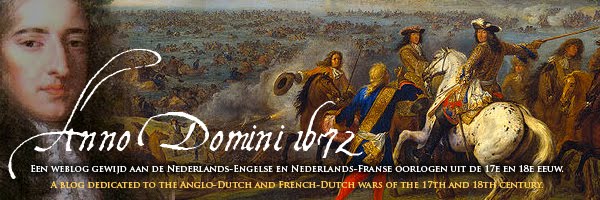
De stad Grave was al in de tachtigjarige oorlog het slachtoffer van belegeringen. In de Guerre d'Hollande werd de stad door de Fransen belegerd en in 1674 weer door de Unie ingenomen. Het beleg werd uitgevoerd onder leiding van Rabenhaupt, en was in het begin geen succes. De stad was versterkt door de Fransen en door de traditionele wijze van naderen, konden de belegerden diverse malen uitvallen doen. Pas de komst van Willem III met extra troepen zorgde voor een einde van het beleg. Van Rabenhaupt had ik beter verwacht. Het tweede plaatje is een legenda. het is me even duister of die nou bij deze plaat hoort, maar het mooie is dat et laat zien wie bij de belegering betrokken waren:
Staatse zijde:
Zijne Excellente Willem III
Col Kirkpatrick, Regiment Schotten van Scott of Bucleuch
Frederik Casimir, Prins van Koerland, Regiment van Coerland
(Lt-)Col Wijnbergen, Regiment van Wijnbergen
Col Golsteyn, Regiment van Golstein
Zijne Excellentie Rabenhaupt
Brandenburgers, Reg Lehndorf?
Col Hendrik van den Clooster, v/h Regiment Wijnbergen?
Col Ulenbourg ?
15 batterijen geschut
3 batterijen mortieren

The city of Grave had to endure several sieges, two of them in the eighty years war and two in the Guerre d'Hollande. The siege in 1674 was led by Rabenhaupt, which wasn't quite a succes as the French several times managed to attack the State's troops, mainly caused by an outdated way to approach the city. Only when William III showed up with extra troops, the French garrison surrended, by order of Louis XIV himself. The list is based on a legend, connected with another plate of the siege, and lists the commanders and thus the regiments.




Would it be possible to have a copy of the other plate of the siege of Grave that lists the commanders. I believe that Golstein is in fact Holstein. I'm not certain about Ulenbourg. Have to do more investigation. All of the others are indentified correctly, but the number of regiments does not seem adequate to conduct a siege, or are these regiments that arrive with the Prince of Orange.
BeantwoordenVerwijderenDan
The legend is on the mail Dan.
BeantwoordenVerwijderenThanks so much. There is one regiment you missed - Nieuland or Ingen-Nulant. I believe Ulenbourg is possibly Eylenburgh. By the way, I am using Het Staatsche Leger Deel VI.
BeantwoordenVerwijderenDan
A correction - there is a Regiment Goltstein.
BeantwoordenVerwijderenDan
Het Staatsche Leger VI reports on p. 34 that seven regiments of cavalry and 16 regiments of infantry took part in the siege under Rabenhaupt. Also a Brandenburg Contigent under Alexander van (!) Spaen and 2900 Spanish troops were available. 4600 civilians from three provinces helped as well.
BeantwoordenVerwijderenOn October 9th the Prince (=William III) appeared with all the cavalry (listed on pp 30 and 31) of the field army, plus some infantry.
From the list of the casualties we can confirm the following regiments as well:
Regiment Lutzowm
Regiment Wagenem
Regiment van Reuss en Plauen
Ulenbourg could - indeed - be Eylenburgh, but there's a big difference between the Ey sound and the U sound, but it's possible that Mr Eylenburgh used a more posh name of course!
Interesting is that according to a resolution (in this case this means archived note) of the Raad van State all regiments were 'eenderhand gekleed', therefore 'uniformed'.
So the "brandenburgers could be the units under GM Spaen, rather than Regt Lehndorf. Any suggestions for Ulenbourg?
BeantwoordenVerwijderen